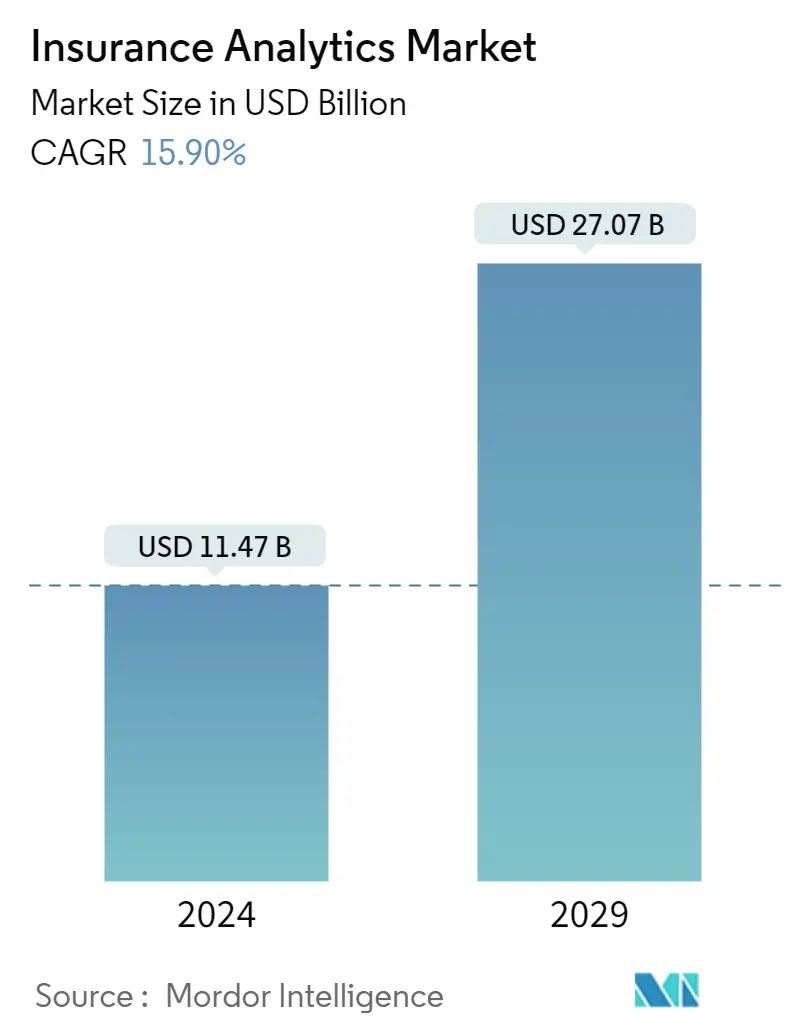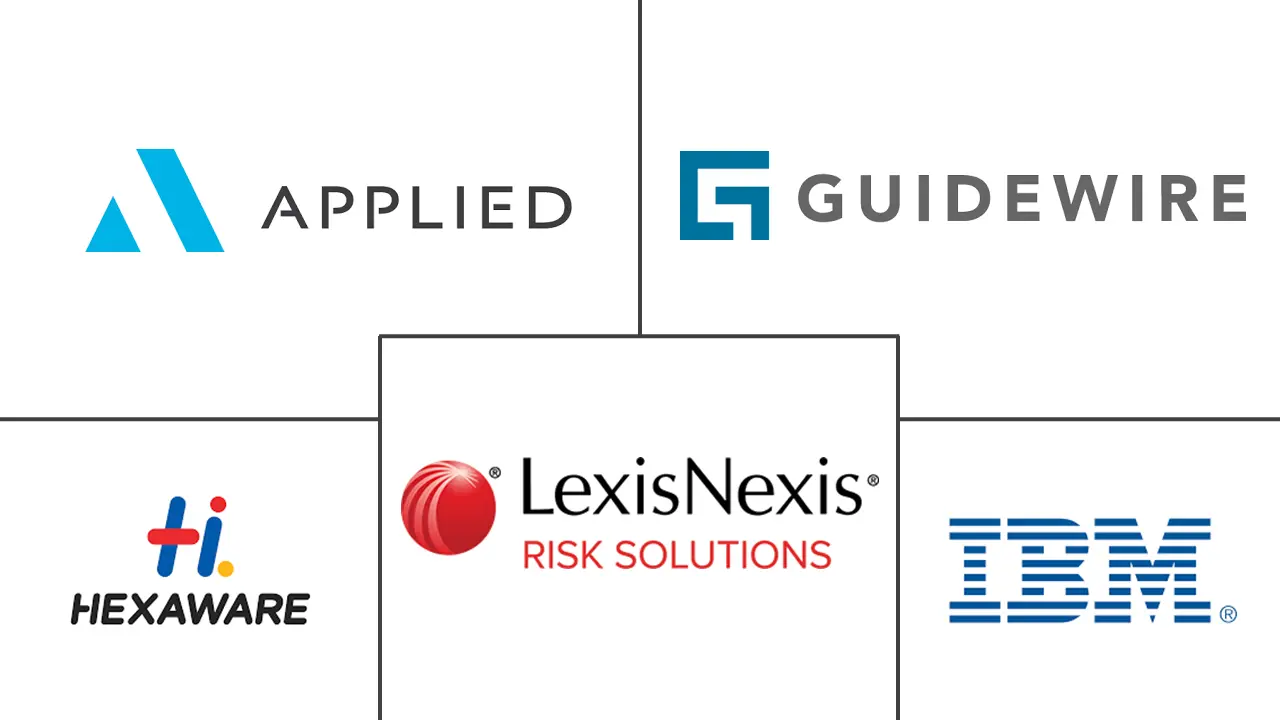Market Size of Insurance Analytics Industry

| Study Period | 2019 - 2029 |
| Market Size (2024) | USD 11.47 Billion |
| Market Size (2029) | USD 27.07 Billion |
| CAGR (2024 - 2029) | 15.90 % |
| Fastest Growing Market | Asia Pacific |
| Largest Market | North America |
| Market Concentration | Medium |
Major Players
*Disclaimer: Major Players sorted in no particular order |
Insurance Analytics Market Analysis
The Insurance Analytics Market size is estimated at USD 11.47 billion in 2024, and is expected to reach USD 27.07 billion by 2029, growing at a CAGR of 15.90% during the forecast period (2024-2029).
Companies can identify dubious claims, fraudulent activities, and behavioral patterns using predictive analytics submitted for further research. This will improve the efficiency of claims, policy, and sales processes helping in sound business decisions. For instance customer lifetime value (CLV/CLTV) tool provides the client's informative insights that enable forecasting the possibility of customer behavior and attitude, policy maintenance, or a policy surrender.
- These solutions are becoming more valuable with AI and machine learning integration. Using AI in the financial sector might boost profitability rates by 31% by 2035, according to a report by Accenture. Additionally, AI will likely make it possible to give tailored financial services to clients, improving the customer experience. As a result, AI-based insurance analytics solutions can help financial organizations cut costs by billions, increase revenues by billions, and decrease fraud. Advanced Analytics (AA) increased the operating profit of the top four performers by 10 to 25 percent in EMEA. They anticipate this impact to grow over the following two years.
- With the onset of the COVID-19 crisis, structural changes brought on by turbulence, uncertainty, and weak economic activity had essential ramifications for the insurance sector. These changes compelled insurance companies to rethink how they conducted business and interacted with customers. Also, the need for digital interactions and enhanced risk management for personal and health boosted investments in digital and analytics solutions. As a result, market growth was predicted throughout the study period.
- Data reliability and security are significant due to increased connection and distant accessibility. Concerns about nefarious parties getting access to personal data are very high. Historically, insurance companies have yet to be known to make significant expenditures in infrastructure, so purchasing and maintaining pricey security software will hinder the growth of the Insurance Analytics Market.
- With the rise in competition in the insurance sector, the need for analytics solutions tends to rise to sustain stiff competition across the global market. Companies are adopting scalable & efficient solutions for managing amplified risk, dealing with catastrophes, and meeting demands of regulatory scrutiny, which are some of the significant factors that propel the adoption of insurance analytics.
- Furthermore, as consumers are inclined toward getting online quotes & customized insurance solutions 24/7 from different companies, it creates competition among industry firms. Therefore, an increase in competition is accelerating the adoption of insurance analytics among key players in the market.
Insurance Analytics Industry Segmentation
Insurance Analytics is used to streamline the procedures for calculating and evaluating insurance risks and making judgments about insurance products. Insurance brokers and organizations may quickly analyze expenses using insurance analytics tools and solutions, ensure stable financial operations and liquidity, and keep tabs on operational costs like those associated with sales, marketing, operations, or customer service.
The insurance analytics market is segmented by component (tools and services), business applications (claims management, risk management, process optimization, customer management, and personalization), deployment mode (on-premises and cloud), end-user (insurance companies, government agencies, and third-party administrators, brokers, and consultancies), and geography (North America, Europe, Asia-Pacific, and Rest of the World). The market sizes and forecasts are provided regarding value (USD).
| By Component | |
| Tool | |
| Services |
| By Business Application (Qualitative Analysis) | |
| Claims Management | |
| Risk Management | |
| Process Optimization | |
| Customer Management and Personalization |
| By Deployment Mode | |
| On-premise | |
| Cloud |
| By End-User | |
| Insurance Companies | |
| Government Agencies | |
| Third-party Administrators, Brokers, and Consultancies |
| By Geography | |
| North America | |
| Europe | |
| Asia-Pacific | |
| Rest of the World |
Insurance Analytics Market Size Summary
The insurance analytics market is poised for significant growth, driven by the increasing integration of AI and machine learning technologies. These advancements are enhancing the efficiency of claims processing, policy management, and sales strategies, enabling companies to make informed business decisions. The market is experiencing a surge in demand as insurers seek to leverage predictive analytics to identify fraudulent activities and behavioral patterns, thereby improving risk management and operational efficiency. The COVID-19 pandemic has further accelerated the adoption of digital and analytics solutions, as insurance companies are compelled to enhance their digital interactions and risk management capabilities. This shift is fostering a competitive landscape where companies are investing in scalable and efficient analytics solutions to meet regulatory demands and manage amplified risks.
In the Asia-Pacific region, the insurance analytics market is driven by the growing adoption of digital infrastructure and the need for customer and behavioral analytics. The urbanization trend in this region is creating opportunities for insurers to capture a new customer base, with data analytics playing a crucial role in understanding this demographic. Insurance companies are increasingly automating processes and digitally enabling distribution channels to enhance service delivery. Regulatory changes in the region are also promoting InsurTech and policyholder protection, further fueling market growth. Key players in the market are investing in innovative product offerings and forming strategic partnerships to expand their digital capabilities and cater to the evolving demands of the insurance industry.
Insurance Analytics Market Size - Table of Contents
-
1. MARKET INSIGHTS
-
1.1 Market Overview
-
1.2 Industry Attractiveness - Porter's Five Forces Analysis
-
1.2.1 Bargaining Power of Suppliers
-
1.2.2 Bargaining Power of Consumers
-
1.2.3 Threat of New Entrants
-
1.2.4 Threat of Substitutes
-
1.2.5 Intensity of Competitive Rivalry
-
-
1.3 Assessment of the Impact of COVID-19 on the Industry
-
1.4 Market Drivers
-
1.4.1 Increased Adoption of Advanced Technologies
-
1.4.2 Rise in Competition among the Insurance Sector
-
-
1.5 Market Restraints
-
1.5.1 Stringent Government Regulations
-
1.5.2 Privacy and Security Concern
-
-
-
2. MARKET SEGMENTATION
-
2.1 By Component
-
2.1.1 Tool
-
2.1.2 Services
-
-
2.2 By Business Application (Qualitative Analysis)
-
2.2.1 Claims Management
-
2.2.2 Risk Management
-
2.2.3 Process Optimization
-
2.2.4 Customer Management and Personalization
-
-
2.3 By Deployment Mode
-
2.3.1 On-premise
-
2.3.2 Cloud
-
-
2.4 By End-User
-
2.4.1 Insurance Companies
-
2.4.2 Government Agencies
-
2.4.3 Third-party Administrators, Brokers, and Consultancies
-
-
2.5 By Geography
-
2.5.1 North America
-
2.5.2 Europe
-
2.5.3 Asia-Pacific
-
2.5.4 Rest of the World
-
-
Insurance Analytics Market Size FAQs
How big is the Insurance Analytics Market?
The Insurance Analytics Market size is expected to reach USD 11.47 billion in 2024 and grow at a CAGR of 15.90% to reach USD 27.07 billion by 2029.
What is the current Insurance Analytics Market size?
In 2024, the Insurance Analytics Market size is expected to reach USD 11.47 billion.

